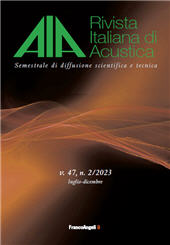Analisi sperimentali e numeriche di cristalli sonici utilizzati in barriere antirumore
25-33 p.
I cristalli sonici sono particolari strutture periodiche ovvero strutture in cui gli elementi che le compongono hanno una disposizione geometrica regolare e ripetitiva. Le loro caratteristiche macroscopiche non dipendono solo dalla loro struttura molecolare, ma anche e soprattutto dalla loro geometria realizzativa. Il presente lavoro si concentra nello sviluppo di questa tecnologia, i cristalli sonici, utilizzati come barriere antirumore. In particolare, verranno confrontati i risultati sperimentali dell'attenuazione sonora acquisiti tramite i test in laboratorio di acustica in sala anecoica e semi anecoica, condotti su barriere a cristalli sonici in scala ridotta (scala 1:3 in pianta e scala 1:2 e 1:4 in altezza), con i risultati numerici ottenuti tramite simulazioni realizzate con il Metodo degli Elementi Finiti (FEM) attraverso l'aiuto del software di calcolo MATLAB.
Quindi, sarà possibile confrontare i valori dei modelli trattati e consideraretale tecnologia come una possibile soluzione alla riduzione dell'inquinamento acustico anche e soprattutto nel rispetto dell'ambiente essendo strutture costituite da scatterers (i singoli elementi che costituiscono le barriere) di materiale riciclato o naturale come derivatidel legno. Ciò nonostante questo lavoro è stato svolto su modelli in scala e dunque i valori ottenuti non sono necessariamente validi per modelli di dimensioni reali. [Testo dell'editore].
Sonic crystals are special periodic structures where the composing elements have a regular and repetitive geometric arrangement. Their macroscopic characteristics depend not only on their molecular structure, but also and above all on their design geometry. This study focuses on the development of this technology, sonic crystals, used as noise barriers. Specifically, experimental results of sound attenuation obtained through laboratory tests in anechoic and semi-anechoic rooms, conducted on scaled-down sonic crystal barriers (1:3 scale in plan and 1:2 and 1:4 scale in height), will be compared with numerical results obtained through simulations realized with the Finite Element Method (FEM) using MATLAB calculation software. Therefore, by comparing these results, it will be possible to assert the validity of the models.
Additionally, it will be confirmed that this technology can be a truly excellent solution for reducing noise pollution, especially in consideration of the environment, as the structures consist of scatterers (the individual elements that make up the barriers) made from recycled or natural materials such as wood derivatives. However, it should be noted that this study was conducted on scaled models, and thus the values obtained may not necessarily be valid for full-scale models. [Publisher's Text].
Fait partie de
Rivista italiana di acustica : 2, 2023-
Articles du même numéro (disponibles individuellement)
-
Informations
Code DOI : 10.3280/ria2-2023oa15485
ISSN: 2385-2615
KEYWORDS
- barriere acustiche, cristalli sonici, strutture periodiche, barriere in legno, metodo sperimentale, metodo numerico
- noise barriers, sonic crystals, periodic structures, wooden barriers, experimental method, numerical method


